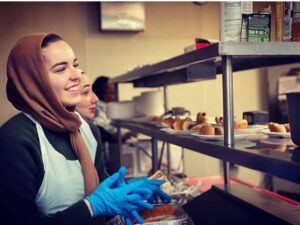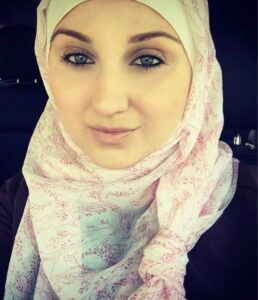Non-profit organization meets the needs of many in our community

J&E Community Relief has grown from a grassroots organization to one that provides several services to the community – including much needed food giveaways. Photo supplied by J&E Community Relief.
By Alan Madlane
Emina Ferizovic is the founder of the Hamtramck non-profit relief center J&E Community Relief (located at 11816 Jos. Campau Ave). We asked her a few questions by email about her non-profit.
The Review: So let’s start with you. Are you sole administrator of the non-profit, or are there others that should also be mentioned? What was the impetus behind creating the non-profit? When did you open your doors?
Ferizovic: I’m the founder of J&E Community Relief. However, our vice president Sabiha Trokic, our amazing board members and our hard-working volunteers are who keep J&E Community Relief going.
In 1996, at age 12, I came to Hamtramck — as a refugee from Bosnia. I have always felt the need to give back to this community, and help those in need.
J&E Community Relief was born in August of 2018; we opened a very small food pantry. Sejla Basic was our first donor, who came to us with a car full of nonperishable food. We split the food into 10 separate packages that were then delivered to our first 10 clients.
Now, two years later, we are feeding over 5,000 individuals monthly, and providing weekly hot meals every Sunday to 260 homeless mothers and children.
The Review: Did anyone have any experience running a non-profit before this? Was it the same type, or different? How many years, and where?
Ferizovic: No, my entire board and I were all new to this experience.
I wanted a diverse board that was willing to do their own research, and bring to the table all the problems our community was facing.
After collecting data, and reaching out to our community through social media, we discovered that many families were facing food insecurity. Teen moms were struggling to provide clothing and other necessities for their new-born babies, and some parents couldn’t afford to prepare their children for a new school year.
So this is what we decided to tackle first. Each volunteer and board member would use his or her personal Facebook page explain to their followers what we were doing, and ask for donations.
Donations of food and baby clothing started pouring in. Only three weeks after we opened our doors, we held our first Back-to-School and Mom-To-Mom events.
Hundreds of students received new backpacks filled with school supplies. We received so much baby clothing, that after taking care of all the local moms who reached out to us for help, we found ourselves delivering packages also to moms in Dearborn, Highland Park, Melvindale, Allen Park; even mailing packages to Grand Rapids.
The Review: So, J & E Community Relief, come into being in August of 2018. Where are you located, and why did you choose that location? Are you renting the space, or did you buy the building?Do you still get most of the items by donation alone, or in other ways now as well?
Ferizovic: We are located at 11816 Joseph Campau Ave. in Hamtramck. With the help of our sponsors, we are able to rent our facility, with a goal of purchasing this building in the future.
Gleaners Community Food Bank is where we purchase most of our food. Gleaners’ free aisle is a huge help – in the months where we don’t raise enough money for food purchases, those free items help out a lot.
A local food distributor — UBC Food Distributors in Dearborn — has been very generous; they have donated thousands of pounds of food to us so far. During this COVID-19 crisis, Farmers to Families Food Box Program and Tom Maceri & Son have each reached out, and together have donated close to 3,000 boxes of fresh produce over the past three months.
The Review: How do you choose what items to put out on the floor; what’s your criteria for inclusion? What will you do with any unwanted stuff after a period of time – particularly perishables? How long is that period of time usually, before you deal with unwanted items?
Ferizovic: We choose items based on our clients’ needs.
By having a diverse board, we are able to include and communicate to everyone, including many clients who do not speak English.
We also work closely with a remarkable group of women from Eastern Michigan University’s Center for Health Disparities Innovation and Studies. They provide material for our clients in three different languages: English, Arabic and Bangla.
Rachel Bessire and Sarah Lally from the center go out of their way to help our clients understand the importance of good nutrition, healthy lifestyles, and how to reduce the risk of chronic diseases.
The Review: What are the center’s hours? How did you decide on them?
Ferizovic: COVID-19 has forced us to reduce our hours. Food distribution is currently occurring only twice a month, every first and third Tuesday of each month at 10:30 a.m.
We do our best to provide enough food to last our clients for two weeks. Other events are scheduled separately, and are announced on our Facebook page, J&E Community Relief, and also on our Instagram page (JECR.US). We recently had our Back-to-School event, and our Mom-To-Mom one is coming up mid-November.
The Review: Your non-profit is a bit unusual, in that you also have food items, in addition to non-food ones. What percentage of what you give away is food, versus non-food, approximately? Are there any special considerations when you are dealing with food, such as pest control?
Ferizovic: Before we could partner up with Gleaners Community Food Bank, we were required to take a course to learn how to safely handle food.
We’ve had multiple inspections; our building is sprayed every six months for pest control. The temperatures in our refrigerator and freezer are checked weekly. The safety of our clients is our number one priority.
Sixty percent of the assistance we provide is related to food. We are now branching out, bringing in other services and resources.
In December of 2019, we added a youth center that included a book club, homework club, many different workshops (for example, one called “The Journey to Self Confidence”), and an art class.
In March of 2020, we were forced to close down due to the pandemic, but we will be restarting these programs as soon as it is safe enough for children and young adults to gather again.
The Review: Do you have any plans to open any other similar non-profits if this one keeps doing well? Where would you go?
Ferizovic: At this time we do not have a plan to open a similar non-profit. Our goal is to grow this organization. We want to focus on being a place that will empower adults and children, and help them prepare for a better future.
The Review: Can people help in other ways?
Ferizovic: People can help by making donations to us, or by volunteering.
The Review: Other than your Facebook page, how do you get word out to people that you exist, and does that seem to be working so far?
It looks like you also post other helpful community info on your Facebook page too, such as the notice about the free online breastfeeding classes put on by Wayne County Health Communities and the Eastern Michigan University REACH Project. So, people should check your Facebook page regularly for all types of community help news, right?
Ferizovic: Our Facebook and Instagram pages are how we reach most of our clients.
We want to create a long-term solution for our neighbors in need. Teaming up with other organizations has helped us bring useful resources, educational materials and employment opportunities to those clients.
And yes, community members should check out our page often for upcoming events, as well as for any job openings that are available through Sentech Services.
Posted Oct. 2, 2020


